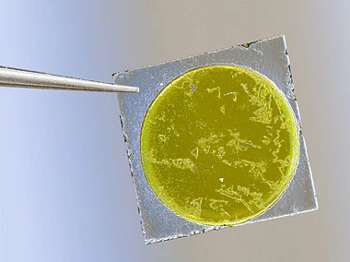- News
20 June 2012
Cubic silicon carbide grown with quality similar to hexagonal SiC
Cubic silicon carbide (3C-SiC) is considered to be very suitable for making highly efficient solar cells but the material quality has been poor compared with the established hexagonal polytypes of SiC. Now researchers in the Department of Physics, Chemistry and Biology at Sweden’s Linköping University say they have developed a method for growing cubic silicon carbide with quality similar to commercial hexagonal silicon carbide (J. W. Sun et al, ‘Considerably long carrier lifetimes in high-quality 3C-SiC(111)’, Appl. Phys. Lett. 100, 252101 (2012); doi: http://dx.doi.org/10.1063/1.4729583).
 Cubic silicon carbide is a perfect material for impurity (intermediate-bandgap) solar cells, say the researchers. For boron-doped cubic SiC, the dopant band of boron in the energy bandgap of 3C-SiC leads to efficient use of sunlight, so that an efficiency up to 48‐60% could be achieved (depending on the theoretical model).
Cubic silicon carbide is a perfect material for impurity (intermediate-bandgap) solar cells, say the researchers. For boron-doped cubic SiC, the dopant band of boron in the energy bandgap of 3C-SiC leads to efficient use of sunlight, so that an efficiency up to 48‐60% could be achieved (depending on the theoretical model).
Picture: Cubic silicon carbide grown on hexagonal SiC.
But the hexagonal silicon carbide polytypes have been commercialized for many years, while cubic silicon carbide has faced challenges. It is metastable, i.e. it does not really want to form. To make it form, the growth temperature has to be decreased, but at the same time the growth rate is reduced. The common approach is to use silicon as the substrate, but the lattice and thermal mismatch causes defects and stress.
The researchers at Linköping University have hence applied a bulk growth approach such as that used in the production of hexagonal silicon carbide. The trick is to lower the growth temperature while adjusting other parameters to maintain a high growth rate. The research group uses hexagonal SiC as the substrate, but the material is transformed to the cubic structure during the initial stage of growth. The advantage of using a hexagonal substrate is the perfect lattice matching.
The growth rate is 1mm/hr, and structural measurements show similar quality to that of commercial hexagonal material. The key parameter that demonstrates the quality is carrier lifetime. Previously, lifetime was about 0.1μs, but the new record value is 8.2μs in as‐grown material (an increase of almost two orders of magnitude). In comparison, this is even slightly better than that of as‐grown hexagonal SiC.
Todays silicon solar cells have an efficiency of about 20%. To increase the efficiency of solar cells, multi-junction (thin-film) solar cells with different bandgaps are among the most promising. The best efficiency for such solar cells demonstrated on the research scale is 43.5%. However, challenges in the fabrication of multi-junction solar cells lie in the growth of multi‐stacked material and balancing the junction currents. In contrast, cubic silicon carbide in a single material that is doped during growth, and with a high growth rate of about 1mm/hr, could pave the way for more efficient solar cell concepts, believe the researchers.
Graphensic spun off from Sweden’s Linköping University for graphene-on-SiC epi
